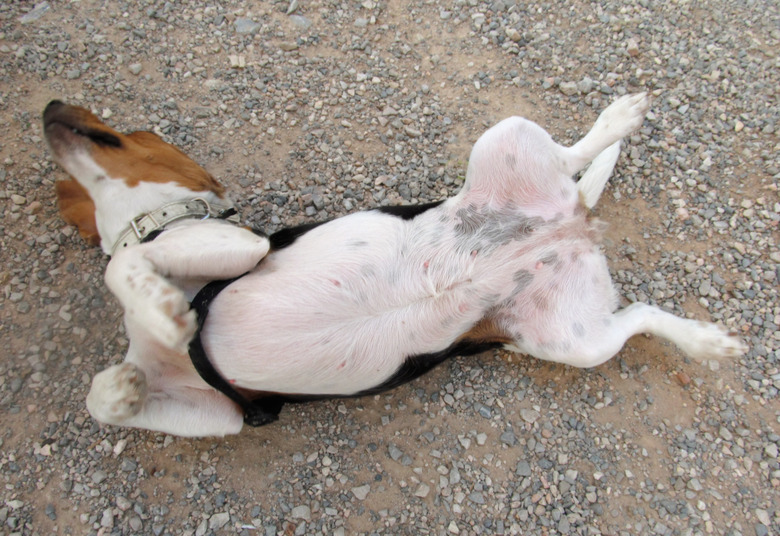Dog With Hair Loss On Stomach & Legs
Dogs can experience hair loss, also known as alopecia, due to many different underlying causes, such as bacterial infections, parasites, metabolic disorders, and allergies. Hair loss on their stomach or legs may be the first sign that something is wrong. Other times, you'll see hair loss as patchy or widespread baldness on the pup's body. Some hair and skin problems have simple remedies, but many conditions can indicate serious medical issues. Veterinary advice is recommended to ensure accurate diagnosis and treatment.
Causes of hair loss in dogs
Causes of hair loss in dogs
Demodectic or sarcoptic mange: Mange is caused by the Demodex mite or scabies mite and can result in widespread patchy hair loss. Mange is most often seen in young dogs with a weak or immature immune system. However, it can also occur in dogs of any age experiencing immune suppression due to serious illness, such as cancer or nutritional deficiencies.
Mange is treated using oral medications and certain monthly flea/tick preventatives that have been proven to treat mange (not all preventatives do).
Canine dermatophytosis (ringworm): Ringworm is a fungal infection in dogs. It tends to occur in individuals who have immune suppression due to other systemic illness. In humans, ringworm is known to cause a circular skin lesion with a red, crusty outer edge, but in animals, it rarely appears that way. More often, it appears as an irregularly shaped area of patchy hair loss.
The hair loss frequently occurs on the face, back, stomach, and legs of dogs. Ringworm is contagious between humans and animals and is treated with an antifungal medication.
Fleas: Dogs can be allergic to flea saliva. The intense amount of itching that occurs from flea bites commonly results in bald patches. Flea infestation in a home can be difficult to get under control, and it's often recommended to keep your pet on year-round flea control.
Canine atopy (environmental allergies): Allergens like pollen or household dust mites can result in skin conditions, like itchy skin, yeast infections, or bacterial infections. Your veterinarian can determine what allergens are problematic for your pet by doing allergy testing.
Canine Cushing's disease: This is an endocrine disorder of the adrenal glands that causes the body to have too much of the stress hormone cortisol. In addition to hair loss along a dog's back, tail, and legs, they will have a potbelly, increased thirst, and increased urination.
Hypothyroidism: This is a common hormone imbalance of middle-age and older dogs that initially may cause hair loss on the tail. Baldness may also develop on the torso. The legs are usually not affected.
Genetic disorders: Some dog breeds are prone to a condition called pattern baldness. This causes alopecia on the belly, back of the hind legs, ears, and neck. Dachshunds are most commonly affected, but boxers, Chihuahuas, greyhounds, and Boston terriers also develop it.
Follicular dysplasia is a less common cause of alopecia in dogs. This causes hair loss on the affected dog's back, and it does not usually make them itchy. Dobermans (especially blue and fawn Dobies), Rottweilers, and retrievers are some of the breeds impacted by this condition.
Other causes of hair loss in dogs: Your dog could also experience hair loss due to stress, dog food allergies, or a metabolic disorder. Your veterinarian will likely diagnose your pup's specific problem by conducting a physical exam; running blood and urine tests; and possibly doing skin scrapings, skin cultures, and/or taking a biopsy for examination. Treatment will depend on the underlying medical problem.
Dog losing hair on legs
Dog losing hair on legs
For a dog losing hair on their legs or stomach, parasite bites or allergic reactions could be the culprit. Some dogs can be bitten by bugs and have no ill effects, while others have allergic reactions that result in hair loss. Flea allergy dermatitis primarily causes hair loss at the tail base, tail, and hind legs.
Hair loss from ticks and insect bites often affects the lower legs, but it can also appear on any area of the body. Sensitive dogs may also have allergic reactions to plants, lawn care substances, carpet, or household chemicals they come in contact with, resulting in irritated or dry skin and hair loss.
Dog bald spot on legs
Dog bald spot on legs
If a dog has a bald spot on their leg, it could be a hot spot. Hot spots develop when a dog licks or chews at an irritated area of skin to the point where they develop hair loss and red, wet sores. These occur more frequently on the stomach and legs, as these are the areas easiest for a dog to reach with their mouth.
Many things can incite a dog to create hot spots, from bug bites to skin irritations. Hot spots are usually treated with topical anti-itch or antibiotic creams, by keeping the wounds dry, and by administering corticosteroids or other medications that address the primary cause of the itch.
Is it normal for dogs to have bald spots?
Is it normal for dogs to have bald spots?
It's not usually normal for dogs to have bald spots. A bald spot could be due to one of the many hair loss reasons listed earlier. If your dog's skin at the area of the bald spot is red or otherwise abnormal (such as scabs or scaliness, darker than normal pigmentation, or oozing), your pet should be seen by a veterinarian.
Should I be concerned about my dog losing hair?
Should I be concerned about my dog losing hair?
In general, yes, you should be concerned about your dog losing hair. There are of course some scenarios, like seasonal shedding, where you expect your dog to lose hair. Also, if your dog is on corticosteroids like prednisone for a long period of time, some of their hair may not grow back for a while after they shed it. That's because corticosteroids put hair follicles into the resting stage of hair growth.
If your dog's hair loss is new or if they are already being treated for a condition that causes hair loss but the alopecia is worsening, contact your veterinarian.
The bottom line
The bottom line
There are many possible reasons for a dog to lose hair on their belly or legs. Some of the common reasons are fleas, skin infections, mange mites, and a less active thyroid gland. If you notice itchy skin, a focal bald spot, or generalized baldness on your dog's body, take them to your veterinarian to have the abnormalities checked. Your veterinarian may also run blood tests to look for underlying health problems.

